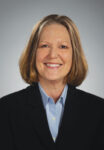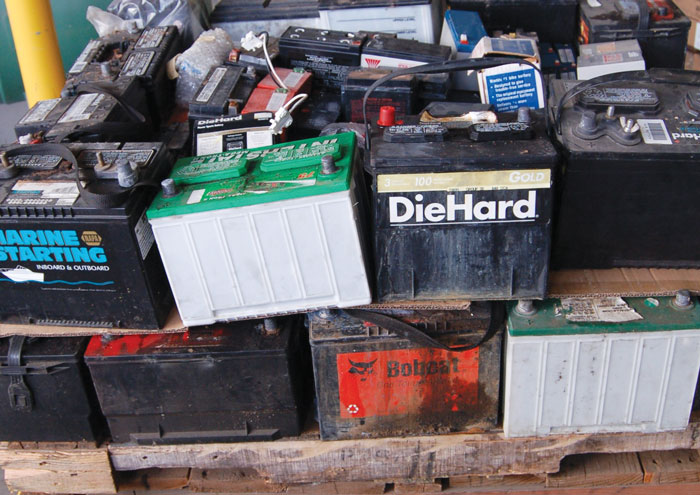This concluding part of the interview with Heidi Sanborn, the Executive Director of the National Stewardship Action Council, will provide examples of the organization’s approach to industry negotiations and recent legislation.
By David Nightingale, CHMM, S.C.

Part one of this interview (Waste advantage Magazine, February 2022) described Heidi Sanborn’s realization of the need for extended producer responsibility (EPR) programs and the lack of economic connection between the business motivation for profits and the resulting externalization of end-of-life costs to local governments for managing toxic and “horrible hybrid” products.
HHW Corner: Can you give us the background and an overview of the new California “Truth In Labeling” (Senate Bill 343, Allen, SB 343) regarding claims of recyclability, allowable use of the chasing arrows, recyclables contamination and toxicity reduction?
Heidi Sanborn: In 2020, I was appointed to the California Commission on Recycling Markets and Curbside Recycling, and we represent a wide variety of interests, including waste haulers, local governments, collectors, recyclers and NGOs. In short, the back-end of the product system. We were tasked with providing the state with recommendations on how to increase markets and recycling as well as define what is “compostable” and “recyclable”. We had unanimous votes of the 16-member commission, one of which defined recyclable to mean hitting 60 percent collection in curbside programs, and 60 percent output to markets before anyone would be allowed to keep the “chasing arrows” symbol on their product.
SB 343 leveraged that set of definitions for compostable and recyclable. It also stated that a product could not be considered “recyclable” when PFAS (Per- and poly-fluorinated alkyl substances) were intentionally added, so we don’t “recycle” toxicity. SB 343 is a bill that NSAC co-sponsored and was hotly contested by product manufacturers. This is when I realized just how important messaging on the labels was to consumers—they really do believe that a chasing arrow implies the product is recyclable, and buy it and put it in the recycling bin, which then contaminates recyclables when it is actually not recyclable.
We hope this “Truth In Labeling” bill is introduced nationally in 2022 because at our foundation, the consumer is the first point of sorting and if the label is lying to them to imply a product is recyclable or non-toxic, they will throw it in the recycling bin and the entire system becomes expensive and ineffective from the outset.

HHW Corner: How would you characterize changes in producers’ attitudes towards product stewardship? Because of historic successes, is it any easier to approach a new industry sector?
Heidi Sanborn: Yes, it is becoming easier. We have been successful in getting legislation passed, and that can be a bit scary for those companies who are not serious about addressing toxicity and recyclability that require change. Historically, we spent too much time just talking nicely about problems, but not really getting any meaningful progress to implement EPR. Industry tends to listen much better when they are unable to stop bills we sponsor. So, those results are driving them to the negotiating table a lot faster than before we had shown we could pass good bills without their support.
As long as industry folks are working collaboratively at a good pace and doing pilots to answer questions and develop processes and standards, we don’t need to move to the more confrontational legislative process. But if they stop making real progress before the problem is resolved, legislation might be the most efficient and necessary path. Legislation is always the last resort. It is very expensive, it is combative by design. The exception is when everyone agrees that legislation is needed to level the playing field, as we did with architectural paints, mattresses and mercury thermostats, but even then, there was a lot of push and pull to finalize the bills.
HHW Corner: Does that mean that you would be OK withvoluntary product stewardship programs?
Heidi Sanborn: Yes, IF they work. They have to perform and be transparent, not just be a greenwashing campaign. The example of a good voluntary program I always point to is lead-acid automotive batteries. The lead industry has encouraged states to pass significant deposit bills on lead acid batteries so that they can get that raw material back to make new batteries. That is a very good industry run product stewardship system recovery in the high 90 percentiles of all their batteries sold in the US. and mainly run by the battery industry. The lead-acid battery core charge is a big reason for that.
The aluminum industry realized that it was cheaper for them to recycle aluminum than to extract, ship and process the bauxite ore to make virgin aluminum. That system also has been successful for a long time. As long as it is working and there are great recycling rates with transparency that allows for accountability, there is no reason for legislation.
When we approach a company or industry with a problem and they say that it should be voluntary, I say this: Voluntary is voluntary. If you had been voluntarily doing something to effectively solve this problem and show high levels of recycling for your problem product, we would not be having this discussion. But you have not solved this problem voluntarily, so why should I believe you now? It’s too late. It’s already a gigantic problem and you did not care until now, so we have to go to legislation or regulation.
Knowing this, I always tell companies that they don’t want to put themselves in that position. If we are to the point of talking about regulation and legislation, then they waited way too long. If you start to see some problems in the market with your product and local governments are struggling to handle it, you should be talking with us now to start figuring out what to do with pilot projects, recycling standards or other actions to solve the problems proactively. If we are to the point of desperation that we must reach out to you because we have a big problem, a voluntary solution is not going to be feasible; we will be beyond that point.
HHW Corner: If you could have one wish granted regarding national legislation, what would that be?
Heidi Sanborn: That we had producer responsibility for all HHW and all toxic wastes. Packaging is bad, but toxics are slowly killing us and we are not being told the truth about our exposure and the impact on our health. Unfortunately, some of these problems were not addressed early enough.
For instance, we can’t get the mercury and microplastics wereleased to the environment out of the fish we eat. We have unleashed a lot of dangerous materials into the biosphere. I would put toxics and plastics in the same category. Microplastics attract toxics that then end up in fish and plastics are not benign and are made with many chemicals that negatively impact our health. I want to educate people and tell them the truth so that they can protect themselves.
HHW Corner: What are you most proud of regarding your newer organization, the National Stewardship Action Council (NSAC)?
Heidi Sanborn: Taking the lessons learned in California and applying those gave us a blowout first year of success with NSAC both in California and at the national level. Our flushable wipes bill and is already in a national bi-partisan bill HR 4602. The chasing arrows bill that prohibits its use unless the packaging is truly recyclable in that market is very likely to be introduced nationally to create harmony for producers in labeling standards. We are also working to get a national bottle bill introduced as soon as the national infrastructure bills are completed.
In addition, as the chair of the Commission on Recycling Markets and Curbside Recycling, the CA legislature passed 10 bills and two policies based on Commission recommendations. That was a huge success for a brand-new voluntary commission, and I want to thank all of the Commissioners for working closely to get that much done in a short amount of time, and I believe we have been the most successful state commission I have ever observed.
HHW Corner: What do you see as unfulfilled promises of the NSAC program?
Heidi Sanborn: NSAC was formed in 2015, but had no full-time staff until 2020. NSAC’s promise is to drive towards a circular economy in the U.S. We have already engaged with Proctor and Gamble and Kimberly-Clark and other large national companies to agree on removing “flushable” from labeling on wipes and are already working with them on Senate Bill 54 (Allen) in CA, the packaging source reduction and recycling bill. I am very proud of what we have already accomplished and my hope is to pass a national bottle bill, national truth in labeling bills for recyclability and flushability. There are no unfulfilled promises, just timely progress that was planned.
HHW Corner: In what ways could a local solid waste or wastewater organization staff connect with NSAC?
Heidi Sanborn: We have LinkedIn and Twitter accounts where we post a lot of information that anyone can see. In addition, individuals can be members of NSAC for $150 per year because I want everyone to be able to afford to follow what we are doing. We have 10 listservs by product type, we host four to six webinars each year that are free to members, and we speak at many conferences. We invite anyone to consider joining as an individual or organization and they can go to www.nsaction.us/donate for more information on benefits and levels of support. They can always contact me at [email protected] for more information as well.
HHW Corner: What words of wisdom do you have for young environmental professionals?
Heidi Sanborn: You’ve got to love what you do and you have to stay true to who you are and align your work with your soul. When you find that alignment, you will have unlimited energy and passion, you will never “work” a day in your life and you will have great success. If it’s in this field, we welcome and encourage you! It’s a great field of work and after 30 years and I still wake up excited to “get to work” every day because we are making a real difference!
Key advice: learn to read the room (body language). That is the number one problem that I see with young professionals. There are a lot of great advocates with great knowledge or passion, but they don’t read the room to know when to push forward or back off and, therefore, lack effectiveness. With so much work done on computer video calls and cell phones, it is much more difficult to read the room and the younger generation may not be developing the skills they need to be good observers of body language and know when to push harder or let up and how to identify and develop potential new partnerships. To be effective, you need to be a person people want to work with and develop a lot of partnerships to amplify your efforts. The good news is that developing a lot of great working partnerships is a lot of fun too, just like my relationship is with you! | WA
David Nightingale, CHMM, S.C., is Principal at Special Waste Associates (Olympia, WA), a company that assists communities in
developing or improving HHW and VSQG collection infrastructure and operations. They have visited more than 150 operating HHW collection facilities in North America. As a specialty consulting firm, Special Waste Associates works directly for program sponsors providing independent design review for new or upgrading facilities—from conceptual design through final drawings to create safer, more efficient and cost-effective collection systems. Special Waste Associates also published the book, HHW Collection Facility Design Guide. David can be reached at (360) 491-2190 or e-mail [email protected].
Full disclosure – Special Waste Associates is a NSAC member.
Reference
A listing of lead-acid battery laws in U.S. states can be found at https://batterycouncil.org/page/State_Recycling_Laws#
